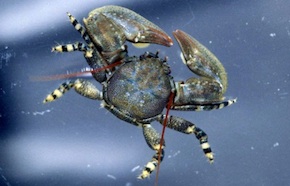Climate change puts coastal crabs in survival mode, study finds
Porcelain crabs can adapt to a warming climate but will not have energy for much else beyond basic survival, according to new research published today from San Francisco State University.
The findings have grim long-term implications for intertidal zone crabs as well as the myriad species that depend on them, and could be an indicator of how other intertidal organisms may respond to a rapidly changing climate.

Researchers exposed Petrolisthes cinctipes porcelain crabs to varying temperatures and pH levels to study their adaptability to climate change.
The study is detailed in an article published in the Journal of Experimental Biology and is the first to explore intertidal zone organisms' response to combined variation in temperature and pH, which is expected to intensify in the future due to climate change and ocean acidification.
"Previous research had looked at constant levels of temperature and pH, but those are really unnatural conditions in the highly variable intertidal zone," said Jonathon Stillman, a professor of biology at SF State and co-author of the study. "We wanted to look at variability in those two factors and see how the crabs would respond to climate change and ocean acidification."
To do so, Stillman and his fellow researchers -- master's student Adam Paganini and post-doctoral scholar Nathan Miller -- placed the crabs in a specially built aquarium designed to simulate the natural environment, including tidal changes. At low tide, with the crabs exposed to the air, the researchers varied the temperature to mirror day-to-day changes the crabs currently experience -- such as cooler air on a cloudy day and warmer air on a sunny day -- as well as conditions expected in the future. At high tide, with the crabs submerged, they adjusted pH levels in the same fashion.
As the temperature rose and pH levels dropped -- conditions expected in the future due to climate change -- the crabs' ability to withstand heat increased. But at the same time, researchers found, the crabs' metabolism decreased. In addition, the combined effect of higher temperatures and lower pH levels was greater than the effect of either of those two factors alone.
"When you combine these things together, they slow down metabolism, which means crabs become sluggish and have less overall energy to do things like growth or reproduction," Stillman said. "If their whole energy budget is a pie, then in the future the size of the pie is going to be smaller, and a larger percentage of it is going to be taken up by survival and maintenance."
Although porcelain crabs are not particularly important to humans -- they are not fishery crabs such as Dungeness -- they are an important food source for coastal fish, birds and other crabs. They can also be seen as a model for scientists to understand the impacts of climate change and ocean acidification on crustaceans in general, according to Stillman. Future studies will look at the impact of varying temperature and pH changes on different species of porcelain crabs, juvenile crabs and crab embryos.
"Temperature and acidification variability reduce physiological performance in the intertidal zone porcelain crab Petrolisthes cinctipes," by Adam W. Paganini, Nathan A. Miller and Jonathon H. Stillman, was published Nov. 12 in the Journal of Experimental Biology. To learn more about the Romberg Tiburon Center, visit http://rtc.sfsu.edu